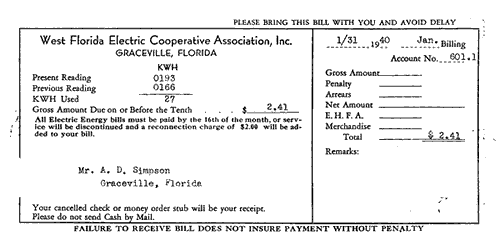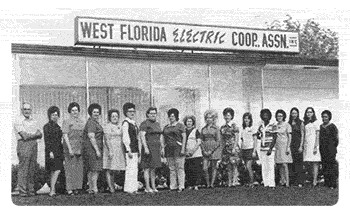Still kicking at 65

Milestones mark the progress of a cooperative effort
West Florida Electric Cooperative recently celebrated its 65th year of service to its member-owners. In honor of the Co-opís rich and varied past, Current Light Flashes is featuring 65 randomly-selected historical highlights in this monthís issue and several to come. The following information is gleaned from a combination of sources, including past and present WFEC members, employees and trustees, publications and newspaper clippings and is not ranked according to
importance or chronological order. Whether you share these memories or most of them happened "before your time," we at WFEC hope youíll be entertained, informed and inspired as you read about some of the events that have bound our cooperative ó and our community ó together.
1. FDR signs the Rural Electrification Act
May 21, 1936
While rural residents of Calhoun, Holmes, Jackson and Washington Counties must continue to rely on kerosene lamps, washboards and wood stoves, the existing, investor-owned power companies deem the sparsely-populated countryside too unprofitable to serve. By executive order, President Frankilin D. Roosevelt authorizes the federal Rural Electrification Administration to make loans, with preference to nonprofit or limited dividend agencies such as cooperatives, for providing electricity to rural residents. Soon area residents begin meeting, organizing, petitioning and collecting signatures to form West Florida Electric Cooperative.
2. Co-op conducts its first by-mail elections
Nov. 1, 2000
WFEC membersí decision, one year earlier, to begin electing trustees by mail ballot, instead of in person, increases member participation in WFECís elections 500 percent. Between mid-October and Nov. 1, the deadline for ballot mail-ins, nearly 6,000 of WFECís approximately 20,000 members, a record number, send in ballots to the certified public accounting firm that will perform an impartial count. The revised voting procedures ensure shut-ins and others who canít attend WFECís annual meeting have an opportunity, for the first time, to take part in their co-opís democratic process.
3. WFECís new Sneads District office opens
Dec. 5, 1988
The Co-opís new office and warehouse in Sneads at the former site of the Chattahoochee Motor Company on Hwy. 90 are about one mile east of the previous facility. The Town of Sneads buys the old office, constructed in 1966 to U. S. Dept. of Agriculture Rural Electrification Administration specifications.
4. Japan attacks Pearl Harbor
Dec. 7, 1941
The U. S. enters World War II. WFECís growth slows as electrical equipment becomes scarce, and almost all able-bodied men are drafted to fight; only two men remain to work on the lines.
5. WFECís service area is divided into districts
1952
WFECís members vote to establish nine districts using streams and roads as boundaries. Each district will be represented on the Co-opís board by a trustee who resides in that district and is elected by the membership at large.
6. Hurricane Eloise ravages the Panhandle
September 23, 1975
After the storm, with 135 to 150 mile per hour winds, comes ashore in Walton County, some WFEC members are without power for seven days.
7. WFEC introduces local Internet service
August 1997
Previously, a lack of local service providers has forced many area residents to pay 20 cents or more each time they connect to the Internet. By January 2003, WFEC serves over 5,100 subscribers with five local access numbers and offers high-speed Internet service via two-way satellite, as well.
8. WFEC hires its first engineer
1939
E. P. McClain, of Mountrie, Ga., is the man for the job.

Page created and maintained by West Florida Electric Cooperative, Inc. © 2001.
designed by embryo design